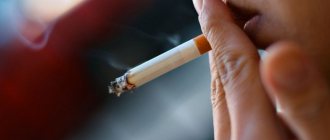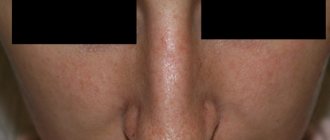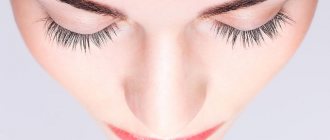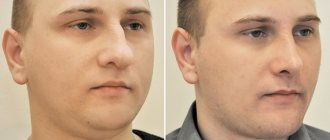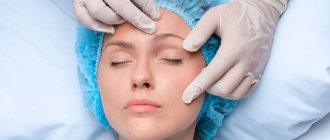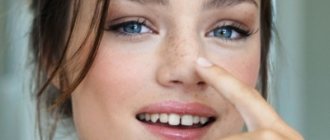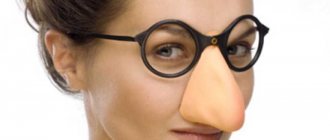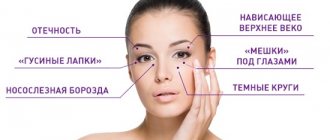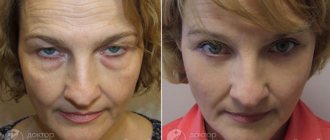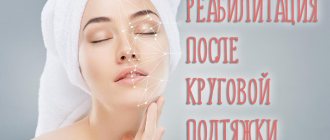The doctor examines the patient, takes a photo of the nose and listens to expectations from plastic surgery - what shape of the nose would like to be achieved, what to remove.
Computer modeling allows you to visualize the result of the operation in advance and discuss it with the patient. If the patient is satisfied with everything, the doctor tells how to prepare for rhinoplasty, gives directions for tests and hardware diagnostics.
The doctor must be informed about existing chronic diseases, bad habits, allergic reactions, intolerance to any drugs and local anesthesia.
Plaster application after rhinoplasty
Many people are unhappy with the shape of their nose, and therefore go under the knife, no matter what. And until they wake up after anesthesia, they don’t even suspect how difficult the first week and a half after the operation will be. The first thing that awaits the patient:
- hematomas on the face;
- swelling;
- painful sensations.
And this is only a small part of what has to be endured. You have to sleep on your back so that your head is as high as possible. There are turundas in the nose that interfere with breathing, and the most corrected nose has plaster on it. This is what irritates many people. But, as it turned out, this is not just a way to fix the operated olfactory organ. This is also a method to avoid severe complications.
Plaster after rhinoplasty allows you to:
- Maintain the shape that the surgeon gave the organ.
- Avoid severe swelling.
- Reduce the appearance of hematomas.
- Helps reduce bleeding.
- Protects against infections.
Such “decoration” must be endured not for the sake of the doctor’s whim, but for one’s own health. Plaster after rhinoplasty does not look very beautiful in the photo, but with its help you will speed up your functional recovery.
Rehabilitation after plastic surgery: why do we need special recovery programs?
You can find out more about recovery after mammoplasty, liposculpture and other aesthetic interventions on our website, and in more detail - at an appointment with a plastic surgeon
.
Hematomas and swelling after surgery, unfortunately, are inevitable. The minimum period required for tissue restoration after blepharoplasty and facelift is 14-30 days.
Rehabilitation after body surgery usually lasts 2 times longer. Of course, much depends on the specifics of the surgical intervention and the individual characteristics of the body.
Each patient always has a choice: to undergo an additional rehabilitation course or not. However, it is important to understand that rehabilitation programs are not only aimed at reducing rehabilitation or reducing pain. Electrostatic and lymphatic drainage massage, ultraphonophoresis and injection procedures have a beneficial effect on the skin at the cellular level. The restoration course is an excellent solution for those who strive for the best aesthetic result, want to take care of their skin and begin rehabilitation after plastic surgery with self-care, which is necessary to consolidate the impressive effect!
After what period is the plaster removed?
The question of when the cast is removed after rhinoplasty is relevant for everyone who has had or plans to have rhinoplasty. This is not surprising, because it causes inconvenience, does not allow you to return to work, fully walk outside, or engage in physical exercise.
When the plaster will be removed depends on the individual patient's indications
In most cases, before removing the plaster, the turundas are removed; this is done after 24 days have passed from the date of the operation. If any contraindications are found, the plaster may be removed only after 72 hours. Plaster is a more serious protection, so it is recommended to wear it for 8-10 days. But after removing such a device, swelling will still be observed, this phenomenon is considered normal.
If swelling does not go away for a long time
Sometimes there are situations when changes in tissues remain longer than usual or increase. In these cases, you need to consult a doctor. The time it takes for swelling to subside after rhinoplasty depends on age, tissue characteristics and additional factors that need to be taken into account. During the examination, the doctor will make sure that there are no complications, and swelling and bruising are consequences of the operation, and not additional problems after it. To speed up the healing process, the doctor may recommend local medications (gels, creams) or a course of procedures that improve fluid outflow and microcirculation.
Is it possible to do without plaster?
Many surgeons recommend not to put a plaster on the nose, but to use a special medical splint to maintain the shape. This is a bandage that is durable and can protect even from severe damage. It is recommended to wear the splint for the same amount of time as the cast.
Although both the cast and the splint bring inconvenience and unpleasant sensations, they must be worn. This will allow you to achieve the maximum result from the operation.
The essence and types of rhinoplasty
Rhinoplasty can be performed for both aesthetic and functional reasons.
- Combining nasal reshaping with septoplasty can effectively treat certain breathing problems.
- Rhinoseptoplasty is also a reconstructive surgery aimed at correcting a birth defect or injury, such as a broken nose.
- It is performed under intravenous sedation or general anesthesia.
The process of removing plaster after rhinoplasty
After the specified time has passed from the moment of the operation and the application of the plaster, they come to the plastic surgeon to remove the plaster.
After rhinoplasty, it is contraindicated to independently manipulate this medical attribute. There are many reasons for this. You can introduce an infection into the affected area and worsen your own health. But the most important thing: you can nullify all the results of the correction. And then you shouldn’t blame the doctor, because it was the patient who, through his actions, led to such an outcome.
When rhinoplasty is performed, removal of the cast is strictly contraindicated, even after a ten-day period, if the doctor decides to prolong walking in it. With the help of a medical attribute, you save deformed tissues from external influences and damage. Plaster is always combined with tampons, which are inserted into the nasal passages. All this will interfere with breathing and cause significant discomfort. You need to be patient and wait.
What tests need to be done before rhinoplasty?
The main requirement for rhinoplasty is to identify the general state of health and possible contraindications. To do this, the patient must take tests and undergo examinations:
- General blood analysis.
- Biochemical blood test (total protein, ALT, AST, total bilirubin, creatinine, urea, glucose, electrolytes).
- General urine analysis.
- Analysis for blood group and Rh factor.
- Blood test for HIV, syphilis and hepatitis B and C (HBsAg, HCV).
- Blood test for coagulogram.
- ECG.
- Fluorography.
The therapist gives a conclusion about readiness for surgery. If there are concomitant diseases, then consultation with a specialized specialist will be required. To prepare for anesthesia, you will need to visit an anesthesiologist.
What should you not do while wearing a cast?
Many people do not understand that a doctor's advice must be taken seriously. This is due to the fact that you not only must maintain the resulting shape of the nose, but also your own health. The risk of complications is especially high during the rehabilitation period in the first two stages. The most important of them is wearing a cast for a week or more.
In order not to introduce an infection into the operated area, not to injure already damaged tissues and not to spoil the work of the plastic surgeon, we recommend adhering to the following “don’ts”.
Contraindicated when wearing a cast on the nose:
- Taking a shower in general. You will have to wash your body and head separately so as not to wet the bandages and cause them to become deformed.
- You will have to forget for a while about the pool, going to the sauna.
- Heavy physical activity and sports are prohibited.
- Prolonged sneezing is also contraindicated. Here you will have to learn how to do it through your mouth.
- Sleep on your stomach or face down.
- Remove, adjust or do anything else with the plaster yourself.
When rhinoplasty is done and the cast is removed, the doctor will then tell the patient how to behave during the rehabilitation period. It is likely that at first it will still be difficult to breathe. After removing the plaster, you will have to rinse your nasal passages daily with the utmost care. For about three more months, patients will see swelling and bruising in the mirror. But if you had not had a cast on from the very beginning, the symptoms would have been more pronounced, the swelling would have spread to the cheeks and neck to a significant extent. We recommend following your doctor's advice exactly so that the results obtained are worth the effort and patience.
How to reduce swelling and bruising
At first, when the swelling is most pronounced, you just need to be patient. The doctor will recommend medications and additional procedures that help reduce swelling for a few hours. But while the tissues are healing, they will not go away completely.
To relieve swelling after rhinoplasty, there are a number of recommendations that should be followed from the first days and at each stage.
Key recommendations in the first week of rehabilitation:
- swelling goes away faster with rest and sleep in a semi-sitting position;
- in the first week you should not massage or put pressure on your face or use cosmetics;
- it is important to exclude elevated temperatures (beach, saunas, hot baths);
- sharply limit any physical activity, especially with sharp tilts of the head or body forward and down.
In the second or third week of recovery, it is important to:
- Avoid sleeping on your side or stomach, especially with your face in the pillow;
- avoid sudden displacement of the skin and underlying tissues on the face (massage, overload);
- avoid exposing swollen areas to heat;
- limit physical activity to household chores only.
The doctor may recommend ointments, gels with decongestant, anti-inflammatory components.
During the second or third month after surgery, swelling remains in the area of the back or tip; for a speedy recovery, doctors recommend giving up smoking and drinking alcohol, and putting pressure on the damaged tissue with glasses, fingers, and various objects. You should also avoid prolonged tilting of your head forward and down.
If by the 4th month the tissues are still swollen, a course of physiotherapy prescribed by your doctor will help relieve nasal swelling after rhinoplasty.
Will it be possible to remove the cast without the help of a doctor?
Only those who do not want to spend money on the services of a specialist can remove the plaster themselves. But in this case, the plastic surgeon may refuse to be held responsible for the result obtained from the performed rhinoplasty if he suspects that such actions were carried out. You should not engage in “amateur activities” regarding turundas and seams.
Sometimes there are cases when the splint and plaster come off on their own. In such a situation, it is recommended not to panic, but to immediately contact a specialist. It is strictly forbidden to independently remove bandages that have been secured by a doctor.
Rehabilitation after liposculpture
Body liposculpture allows you to instantly get rid of “fat traps”, recreate an athletic profile and compensate for the lack of soft tissue volume (enlarge your breasts, buttocks). Liposculpture includes liposuction and lipofilling and is a minimally invasive operation (without incisions), since the surgeon performs all manipulations with a special cannula through small punctures in the skin. Our clinic has installed the latest vibration liposuction device PAL Liposculptor
, which makes such a serious and complex operation as gentle as possible - it eliminates damage to blood vessels, extensive hematomas, and bumps on the skin.
However, rehabilitation after liposculpture of the body cannot be called simple, especially if the plastic surgeon worked on more than 2 zones. After the operation, it is important to wear compression garments
, temporarily give up sports training (later it is not only possible to return to it, but it is highly desirable - to consolidate the result) and follow other doctor’s recommendations.
What is recommended not to do after removal?
Plaster is a kind of “shield” for a vulnerable respiratory organ that has recently been amenable to rhinoplasty. Such a device is needed to maintain bone and cartilage structures in the required position. Also, such a solution is necessary to protect the respiratory organ from accidental injury. It is recommended to adhere to the main rule - to eliminate any possible risks.
To do this, you should observe the following:
- Avoid using glasses with heavy frames.
- Sleep exclusively on your back.
- Try not to make sudden movements with your hands.
- When driving a car, it is recommended to wear a seat belt.
- Avoid sports, including going to gyms and fitness classes.
- Also, you should not attend various rallies, concerts, and festivals during the first month after removing the cast.
- Do not take public transport during rush hour.
- For facial treatment, it is recommended to use only special tonics and micellar waters. Perform all procedures as carefully as possible.
Such recommendations will help prevent any mechanical damage to the respiratory organ.
The following techniques are used when performing the operation
- In closed rhinoplasty, incisions are made in the nostrils.
- In open rhinoplasty, an additional small incision is made through the columella, the tissue bridge between the nostrils.
- Both techniques gently mobilize the soft tissue covering the nose. Next, we work with cartilage and bone tissue to obtain the desired shape and size of the nose. If necessary, cartilage tissue is taken from the nasal septum, or in cases of revision, cartilage from the ear or rib may be required. If nasal breathing is difficult, septoplasty is performed to improve breathing. The fabrics are then re-draped and covered. The operation usually lasts two to three hours.
⇒ INFORMATION: How to get rid of a hump on the nose?
Current information from the lips of a plastic surgeon
In order for patients to understand in detail what the procedure for applying and removing plaster looks like, we suggest that you read the interview with the famous Moscow plastic surgeon Gaik Pavlovich Babayan:
What is the purpose of applying a plaster cast after nose surgery?
A plaster cast is necessary to fix bones and tissues, the adjustment of which was carried out during the manipulation process. Thanks to the plaster, the final result that the patient will receive after the operation is formed. This allows you to hold the bone and eliminates the possibility of displacement due to swelling. The plaster also additionally protects the area where the operation was performed from mechanical damage. If plaster is applied incorrectly or at the wrong time, there may be side effects - including the risk of completely losing the shape that was the desired result.
How is plaster applied?
First, the surgeon prepares pieces of the required size using a special bandage with plaster. Adds water to the fabric - the dressing hardens. This type of protective device can consist of 5 levels, each of which plays an important role - it provides an antiseptic effect, protects against injury and various types of damage.
How long do you recommend wearing a cast after surgery?
In 95% of cases, plaster is applied for 7-14 days. After this you can safely remove it. Sometimes you have to change the plaster. This happens extremely rarely, but still occurs due to the patient’s fault. This can happen due to intentional or accidental deformation of the bandage, its loosening, or removal. Also, the plaster cast must be changed if it gets wet during the bath procedures.
Is there any pain during plaster removal and what does the procedure look like?
The procedure for removing the plaster cast is not pleasant, but there is no painful sensation as such, rather just discomfort. The entire procedure will take a professional surgeon 6-10 minutes. The patient sits on the couch, and the doctor takes the necessary instruments and performs the required manipulations. It is very important that the movements are careful and that the bandage comes off as a single layer.
Will there be swelling after removal?
There is no swelling immediately after surgery because it is contained by the bandage. After the fixation is removed, the swelling intensifies. This phenomenon is considered normal and will pass after a certain time.
What to do with the itching that occurs under the bandage?
Itching is a normal consequence of wearing a cast. You'll have to wait a few days. It is strictly forbidden to scratch your nose with various improvised objects, such as a toothpick or tweezers. When performing such manipulations, you can break the bandage and make its fit less tight. This will lead to improper fusion of cartilage and bone structures.
What would you recommend not to do while wearing a cast to get the desired result?
I usually talk about all the recommendations during the consultation. The only thing I would like to emphasize is to try not to drip water onto the bandage. Of course, this is difficult, but if you do not let the plaster come into contact with water, you will be able to achieve the desired result faster, and you will not have to re-apply the bandage.
More about procedures
Microcurrent therapy
Microcurrent therapy is the therapeutic use of low-frequency pulsed currents of ultra-low power to restore cellular metabolism. This therapy helps eliminate swelling and pain, feelings of parasthesia (numbness) in the postoperative period, enhances lymph flow and blood flow, stimulates cellular respiration, and increases tactile sensitivity. Microcurrents normalize the membrane potential of cells, open ion channels, activate cell enzymes, increase the synthesis of ATP, protein and lipids, accelerate tissue differentiation and regeneration.
Indications:
swelling of the face, eyelids, bruises, pain, consequences of injuries.
Contraindications:
pacemaker, cancer, diseases of the membranes of the brain, neuroses, psychogenic and ischemic pain.
Detox program
Using mesotherapy
cellular metabolism is restored, antioxidant therapy reduces the negative impact of anesthesia on the condition of the skin.
To improve the condition of your hair, you can use trichological meso-sessions
- they stimulate blood circulation in the hair follicles.
After the meso-detox program, lymphatic drainage and blood circulation improve, and free radicals are neutralized. As a result, healing occurs faster and the quality of the skin improves.
The procedure can be prescribed immediately after the sutures are removed in the postoperative period. The number of sessions is from 1 to 10, conducted once a week.
Peptide amino acid therapy
It is applicable both before surgical interventions for the purpose of tissue preparation, and after: plastic surgeries, laser procedures, thread lifting, chemical peels.
Photodynamic therapy HELEO4
The hardware procedure of photodynamic therapy is based on the influence of light rays of different directions. It can be used for rehabilitation after plastic surgery or invasive cosmetic procedures, and as an independent or complex procedure to improve skin quality, for skin health, for rejuvenation and lifting purposes. Can be used for both face and body. The number of procedures per course is determined individually.
The program on the device itself is also individually selected, the parameters of which can be adjusted by the doctor. The uniqueness of the therapy is that the device acts on cells that no longer perform their functions fully, removes them from the body, and also stimulates the work of fibroblasts. That is why the effect is so noticeable.
Procedure: The doctor applies a photosensitizer gel with the necessary set of components. After a certain exposure time, the HARMONIA LED PRO photodynamic lamp comes into operation. Special glasses are required during the procedure for both the doctor and the patient. For about 30 minutes, under a blanket, the patient lies under a light lamp. Photodynamic therapy HELEO4 is an extremely comfortable procedure that does not require anesthesia.
Indications: Age-related, structural changes in the skin, preparation for invasive procedures, accelerated recovery after plastic surgery and other damaging effects (laser, injections, etc.), various skin pathologies, post-acne, etc.
Contraindications: Exacerbations of chronic diseases, epilepsy, pregnancy, photosensitivity, skin cancer, autoimmune skin diseases, therapy with photosensitizing drugs, patients with poor adaptation to light, large doses of radiation exceeding the compensatory capabilities of the body, which have a pronounced negative effect.
More details about the procedure with comments from a cosmetologist: Photodynamic therapy HELEO4
The use of photodynamic therapy HELEO4 is successfully used as rehabilitation after plastic surgery and invasive cosmetic procedures.
Emotions after surgery
After rhinoplasty of the wings and tip of the nose, doctors strongly recommend restraining emotions. This process can cause the surgical sutures to come apart, which in turn causes scarring.
Even sneezing must be done with extreme caution. It is worth avoiding upper respiratory tract diseases as much as possible, as they can lead to unwanted nose blowing and sneezing.
In case of illness, cotton swabs can come to your aid to help gently clean the nasal passages. You can allow yourself to blow your nose only a month and a half after rhinoplasty, in the absence of complications.
Advice! If you can't stop sneezing, do it with your mouth open. In this case, the pressure on the vessels and sutures will be less.
Recovery after surgery
The rehabilitation period after rhinoplasty reaches several months. During this period of time, it is necessary to carefully and carefully follow all the recommendations of the attending physician. Normal nasal breathing will be restored only after a few days. After rhinoplasty, turundas are inserted into the nasal passages, which will help avoid nasal deformation and absorb excess fluid. This is an unpleasant but necessary measure to avoid complications during the rehabilitation period.
Important! Under no circumstances try to remove the bandage yourself or remove the turundas from the nose, this is guaranteed to cause complications and complicate recovery.
Immediately after the operation, you will most likely have a headache, but this is a common consequence of the procedure, which your doctor should warn you about. You will also feel the “heaviness” of your face, which is also a normal effect. The voice after rhinoplasty will be unusually nasal, this will last from a week to two. If there are no complications, the turundas can be removed after three days, however, due to swelling, nasal breathing will not yet be fully restored.
The cast after rhinoplasty is removed after about 10 days. But even after this, the appearance will be far from ideal. After the operation using the open method, the stitches will still be visible, and the swelling will persist for up to six months.
Do not touch the stitches, otherwise the wound may become infected. Only the doctor has the right to remove the medical thread!


